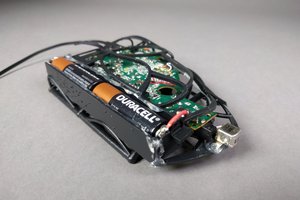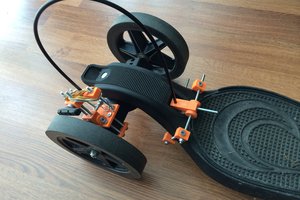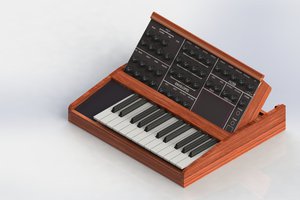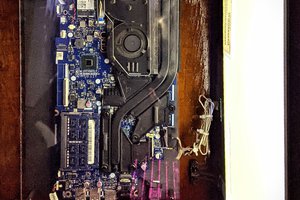Pocket ESP Cardputer
A jack of all trades multi tool for the busy prepper or technician.
A jack of all trades multi tool for the busy prepper or technician.
To make the experience fit your profile, pick a username and tell us what interests you.
We found and based on your interests.
Hey all!
P R O G R E S S ~ The dev boards have entered the building!
As you can see, I may have made a few small mistakes in the routing, but in my defence, I'm new at this, so I only smashed one of my shins with a hammer as penance.
Since I had 5 boards assembled, there are a couple more in the wild right now.
I'm back to working with software again for now, and I'll provide some updates when that's nearing completion.
Stay tuned!
Hey everyone!
Sorry for the lack of updates—I’ve been busy working on things behind the scenes.
The first board order had some issues, so I switched to a cheaper, slightly larger board for debugging. Once everything is sorted, I’ll port the changes back to the smaller board.
Here’s a sneak peek:
I’ll post more updates as soon as these arrive!
Hey all! Been beavering away with Fusion360 trying to make all the components fit nicely - see some cheeky pics.
The neat-ish side:
The dirty side:
I'm not 100% sold on the speaker hole. It uses a smartphone speaker and seems compact enough to give me a little free space on the board, but I might swap it out for a slightly larger model if we don't need that extra space next to the screen for anything.
Here's the speaker currently in use:
Seems pretty decent for the size!
And here's the latest version with the screen and speaker in place (excuse the quality of the 3D print, I'm on the dregs of the roll now).
That's it for now! I have some sample PCBs on order to test some power rail designs for efficiency and such. If all goes well, we should have some initial versions of the board early January.
Thanks for having a look!
Catch you soon!
Hey all!
Managed to find time this weekend to have a play with the thermal camera and have popped together a sample application to check everything works as expected.
After much tinkering, I've managed to get a screengrab off the board to share with you all!
Just received the prints from JLCPCB, and honestly, it's a mixed bag. I know I was probably expecting too much given the price of the service, but if my cheap Bambu A1 Mini can do better… well, that's a yikes from me.
I had high hopes for the SLS 3201PA-F Nylon (black) and MJF PA12-HP Nylon (grey) prints, but these were definitely the most disappointing.
First impressions were promising: the parts feel tough and flexible, with a nice surface finish and a robust overall feel.
On the downside, both sets of nylon parts came out at different sizes. The front and back halves are undersized by varying amounts, so none of the screw holes line up. Comparing them to my home printer's FDM parts, they’re around 1mm smaller in both the X and Y dimensions.
The SLA resin parts (bottom-left white part in 9600 Resin and back-right off-white mystery resin), however, were mostly a win. I’m amazed you can get prints of this quality for as little as $0.66. The resin parts are tough, just flexible enough to allow the keyboard to actuate nicely, and have a good surface finish with fine text details coming through well.
That said, the walls on the resin prints aren’t perfectly square, which makes aligning the two case halves a challenge. It’s probably worth ordering another round of all the different resins to compare dimensional stability and find the right level of flexibility for the keycaps.
Since then, I’ve made some progress on the 3D model to better fit the screen and speakers. The next update will feature a more finalized version of the casing.
Excuse the poor quality images, I'm terrible at documenting stuff!
I had no idea SLS 3D printing had become so cheap!
To me this is crazy good value, got a bunch of different material/ 3D printing methods arriving in the next few days, this will mean the small batch I intend to produce wont have to be printed on my poor lil bambu a1 mini.
As the keycaps are a built into the shell via some pretty thin plastic ordering these parts meant agreeing that the prints would likely fail, I guess I'll find out soon.
Create an account to leave a comment. Already have an account? Log In.
I would say the form factor, as both front and back are completely flat it lends itself to living in a card wallet as a genuine carry about. I think the larger LCD 1.9 vs 1.14 inch makes it a lot more usable for me personally too, In addition I want a go anywhere thermal camera. I think comparing this to the m5 stack is ultimately unfavourable to this project though as I'm sure those are a lot better put together. I came into this project as a learning experience and thought this would be a good introduction to making my first finished custom PCB designs. I've already learned a lot so far!
Noice! But, if I have one suggestion, it's to lay out the keyboard with the diagonal spacing between Q, A and Z :-) Maybe in version 2.0.
Thanks for the feedback, ill certainly consider it! I will say they keyboard is so cramped that I don't expect many folk will get up to a good typing speed xD It looks a lot bigger in pictures.
I would build several of these for experimentation if you post files. I have been drafting something similar but not gotten as far as you.
I'd love to have more of these in the wild so I'll definitely release the files once I've had chance to test things and make sure there's no glaring problems!
Stay tuned!
Recommendation: If you can breadboard your circuits, always do so; unless of course you are 100% sure that your design will work. I have failed to do this before and it didn't end well. Of course just a suggestion.
Yeah no worries mate, I'm breadboarding stuff as I go. I'll need to move to a pcb soon as I finish up on the keyboard design, just because it uses an io expander for the keyboard matrix and I can't find a small breakout board for it.
I'm actually using a cheap slime vr tracker design I'm working on in parallel to help with this board, can just copy and paste the 3.3v supply.
I'll write an update as soon as I have something concrete to show off!
Super cool project, I hope you continue it instead of leaving it to die like many of these!
Hey! Thanks for the kind words!
Can't speak to how soon it'll get put together but I want this thing in my pocket so it'll happen at some point.
There's always a little progress behind the scenes but I'm terrible as documenting things!
Become a member to follow this project and never miss any updates
By using our website and services, you expressly agree to the placement of our performance, functionality, and advertising cookies. Learn More

 David Troetschel
David Troetschel

 T. B. Trzepacz
T. B. Trzepacz
 Ari
Ari
How would you differentiate yourself from the M5Stack CardPuter?
https://shop.m5stack.com/products/m5stack-cardputer-kit-w-m5stamps3?variant=44078073872641